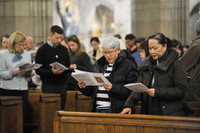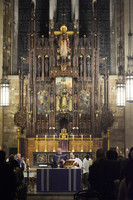


The Dominican Friars are celebrating 150 years of parish ministry on Manhattan’s East Side and the centenary of St. Vincent Ferrer Church, a French Gothic revival structure.
Cardinal Dolan celebrated the vigil Mass at St. Vincent Ferrer Feb. 17. “It was a beautiful experience of our parish being connected to the local Church,” said Father Walter Wagner, O.P., pastor of St. Vincent Ferrer and St. Catherine of Siena parish.
The cardinal was presented a new icon of the two saints together “as an icon of our patronage,” the pastor explained.
The liturgy also marked the beginning of a longer celebration that, according to Father Wagner, “will focus on the days that join St. Catherine’s feast day, April 29, to St. Vincent Ferrer’s feast day, May 5.” (Because April 29 falls on a Sunday this year, St. Catherine’s feast is moved to April 30.)
Although plans are in process, the pastor said that along with Masses that honor the two preacher saints, he is hoping for a procession through the streets between the two churches, a block party and a celebratory dinner.
The two parishes merged on Aug. 1, 2015, as part of the archdiocese’s Making All Things New pastoral planning initiative. St. Vincent Ferrer Church is located at 869 Lexington Ave. at East 66th Street and St. Catherine of Siena Church is at 411 E. 68th St.
The parish has 1,732 registered families. Since the merger, there have been 275 baptisms, 85 First Holy Communions, 207 confirmations, 94 weddings and 86 funerals.
“The merger has been an opportunity for us to clarify and to deepen our mission in the neighborhood, to think more intentionally about having a Dominican presence in a larger way,” Father Wagner said.
“We’re a number of interlocking entities,” he noted, namely, one parish, two churches; two communities of Dominican friars and two communities of Dominican sisters; two Dominican high schools; hospital ministry, and the Dominican Shrine of St. Jude at St. Catherine of Siena Church. “The merger brought all of that together, and so we try more and more to think about it in a wholistic way,” the pastor said.
The parish is also served by a parochial vicar, Father Joseph Allen, O.P.; a vicar for formation, Father Innocent Smith, O.P.; a permanent deacon, Deacon John M. Powers; and a sacristan, Brother Damian McCarthy, O.P.
St. Catherine of Siena began in 1895 as a mission chapel of St. Vincent Ferrer. There were no hospitals in the area at that time. Then-Archbishop Michael A. Corrigan suggested it be named for St. Catherine of Siena, the 14th-century Italian saint who nursed plague and cancer victims.
The Dominican’s hospital ministry encompasses Memorial Sloan-Kettering Cancer Center across the street from St. Catherine’s and the nearby New York Presbyterian/Weill Cornell Medical Center, the Hospital for Special Surgery and ArchCare at Mary Manning Walsh Home.
The Dominican Friars Health Care Ministry of New York includes Father Jonah Pollock, O.P., executive director, and Father John Maria Devaney, O.P., associate director, and four other chaplains.
The two high schools are St. Vincent Ferrer, the parish’s girls’ college preparatory school on East 65th Street, founded by the Dominican Fathers of St. Vincent Ferrer Church and now run by the Dominican Sisters of Our Lady of the Springs and lay staff, and Dominican Academy, a girls’ private college preparatory school operated by the Dominican Sisters of Peace and lay staff on East 68th Street.
To illustrate the order’s outreach, Father Wagner recently shared with CNY a vignette of the people he encountered one beautiful autumn evening while walking to St. Patrick’s Cathedral from St. Vincent Ferrer Church, where he had been pastor since 2010 before the merger.
Historically, the Dominican friars wore a black suit for street clothes; that has changed in recent years, Father Wagner explained, to the white habit, which he wore on the aforementioned encounter.
The first of five people he met that October evening more than seven years ago was a man reading a menu outside a restaurant around the corner from St. Vincent’s. “He looked up and did a double-take” then asked, “‘Excuse me, are you a Dominican?’” After Father Wagner affirmed that he was, the man asked where he lived and was pleasantly surprised to learn there was a Dominican-run church in the neighborhood. “He said, ‘Oh, that’s great to know.’” The second person he encountered was a man seeking money. The third person was a man from England who, after seeing Father Wagner in his attire, jaywalked to ask him if it was Halloween. When Father Wagner said no, and explained that he was a Dominican priest, the man then asked if he was like a monk whose his life was dedicated to God, and said, “‘That’s amazing. I don’t see that at home’” before he went on his way. The fourth and fifth were a mother and son who asked Father Wagner for a blessing.
“The key for us for preaching and being in the neighborhood,” he said, is being an authentic person in public, “you don’t put on a fake persona; you are yourself. Wearing the habit out is not putting on something, it’s being yourself out there. And I think that’s what’s needed, as a basis for preaching and connecting.”
“The general mission of the Dominicans is to preach,” Father Wagner said. “The hope is that we live a Gospel life in our community. That includes, in a specific way to us, a great deal of study.” Subsequently, “all of that prayer, study and common living overflows into the preaching that we do.”
The French Gothic revival building of St. Vincent’s was dedicated in 1918 and designed by renowned architect Bertram Grosvenor Goodhue. It was built on the original cornerstone of a similar building which served St. Vincent Ferrer parish from 1869 to 1914.
Founded and operated by the Dominican Fathers, St. Vincent Ferrer was established shortly after the Civil War and has been at its present location on Lexington Avenue between 65th and 66th streets since that time.
“It’s a church that’s lived in,” Father Wagner said. “People use it all day long to pray. When they open the church at 7:30 in the morning, there are people there who are coming to do their daily business—they’re there to light their candle at their altar on their way to work…
“It’s really a place that is at a crossroads of the city. And everybody’s welcome to come in. And they do.”